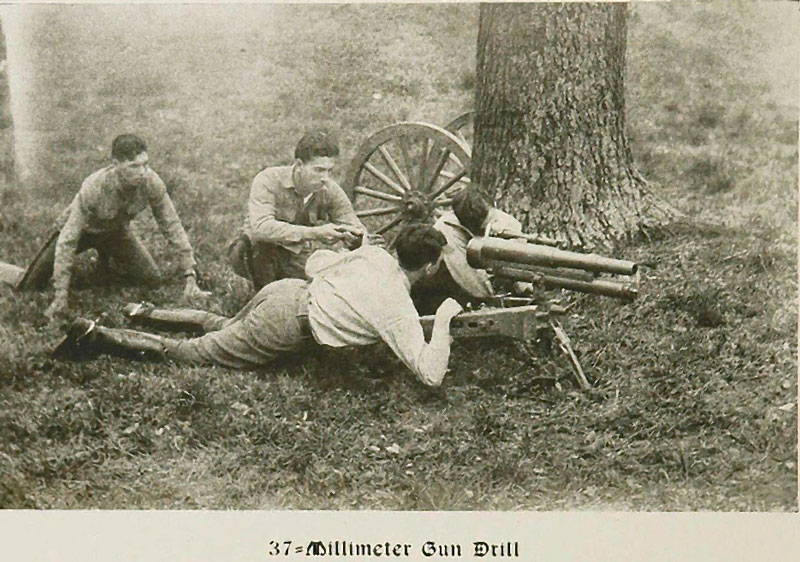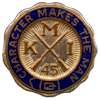
BIG GUNS AT KMI

Sitting
at the entrance to the
main campus area in Lyndon is a 105mm Howitzer, a solitary reminder of
the military school that once existed on the grounds. The
cannon,
known to some former cadets as the Thomas Jefferson Evans IV memorial
cannon,
has remained silent since the fall of 1956.
As
I think back on that fall day,
I can remember only about five minutes of the entire day, but those
memories
are as vivid 47 years later as if they had happened today.
Jeff and
I were members of the Guard Detail, he was the Corporal of the Guard
and
I was the Private of the Guard. During the afternoon, we
argued about
who would fire the cannon during the Retreat Ceremony.
Finally, someone
suggested that we flip a coin to decide the question. It
seemed to
be a reasonable solution, so we flipped a coin and Jeff
won.
As
the Battalion assembled for
dinner formation, Jeff and another member of the guard detail left for
the flagpole. I collected the reports from the formation and
returned
to the Guard House. I seem to remember that the cannon was to
fire
and then the bugle call "To the Colors" was sounded as the flag was
lowered.
The cannon shot was late and when we finally heard the report, it did
not
sound normal. Within seconds, Jeff came running around the
corner
of the Edison building toward the Guard House. His actions
were strange,
he should have been lowering the flag.
Jeff
burst through the Guard House
door holding his left arm and screaming. His hand was badly
mangled
and bleeding profusely. I pulled out my handkerchief and
wrapped
it tightly around his left arm in an effort to stop the flow of
blood.
Someone yelled for me to get Maw Fowler. I covered the
distance between
the Guard House and the Infirmary in near record time. I met
Maw
as she was the leaving the infirmary for the mess hall. I
told her
that Jeff had been seriously injured and she rushed off to the Guard
House.
The rest of the evening is a total blank. Jeff eventually
lost the
middle finger on his left hand and much of the mobility in the fingers
that remained.
Jeff
related two different accounts
of the accident because I doubt that he actually knew what
happened.
The Howitzer used a simulator loaded with a blank 12-guage shotgun
shell
to supply the sound. The simulator was placed in the muzzle
of the
cannon and the lanyard went down the barrel and out the
breech. When
the lanyard was pulled, the simulator fired. On this
particular occasion,
the simulator misfired. In an effort to clear the stoppage,
Jeff
reached up and pulled the simulator out of the barrel with his left
hand.
Whether he bumped the firing mechanism while removing the simulator
from
the barrel or the lanyard caught on the breech and released the firing
pin is a question for which we will never have an answer.
Whatever
caused the simulator to fire, it discharged it's full force into the
palm
of Jeff's hand.
To
my knowledge the cannon was
never fired again. It took a swim in the lake a few nights
after
the accident, an act of revenge by those who had no other way to show
their
frustration and anger. After numerous other late-night excursions
around
the campus, school officials anchored it in place. I never
see the
cannon without thinking of Jeff and wondering what if that
coin had
landed differently.
Note:
During his senior
year, Jeff was one of the Color Sergeants responsible for raising and
lowering
the flag every day.
Tommy
Young
KMI
Class of 59

Thomas
Jeff Evans, IV
04/05/41
- 03/28/01
KMI
Class of '59
|

Miss
Evelyn "Maw" Fowler, R.N.
with
Jeff in the KMI Infirmary.
|
John R. Stork, KMI '69 photograph 2010
 | John R. Stork, KMI '69 photograph 2010
 | John R. Stork, KMI '69 photograph 2010
 | John R. Stork, KMI '69 photograph 2010
 |  |
The Civil War Cannon story:

1935
Herald-Post collection, University of Louisville Photographic Archives.
(As told by Joseph Henry Terstegge, a 1926 KMI Sophomore cadet.)
They
had a Civil War Cannon on wooden wheels on campus at Kentucky Military
Institute. His friends were having a bull session one
afternoon. If you were 16 or over, with your parents’ permission
you could smoke a pipe at school. One of them had a water
pipe. They would share a one pound can of tobacco and smoke it
each week. They looked over at the cannon by the academic
building and thought it must’ve been tough to fight with that
thing. It was full of gravel at the time. They wondered if
they cleaned it if it would work, so they decided to try it. They
thought it would be a good prank to shoot off a gun at Halloween,
thinking it would make a racket, but otherwise be harmless.
So
the boys went to work on it after taps every night for a week, there
were four of them. They raked it out, removed all the grass,
leaves, twigs and gravel and got it clean. The touch hole was
plugged, but one of them thought to drill it out. Bits wouldn’t
be long enough and metal drills wouldn’t work, but a carpenter’s drill
would work. So it meant an extra week of work, but they hand
drilled through it.
They
got a pound of black powder and some dynamite fuse, put the powder in
and saved some to prime the touch hole. They took some wadded
newspaper, using a pole to tamp it in place. Then wet newspaper
and then rags. They had hidden everything and it was ready to go
off at midnight. Grandad was sick in bed when Halloween came and
confined to bed with a cold when his friends took off. It must
have been five after 12 when he heard footsteps and cautious sounds and
doors close, when he heard Kablam!!! The blast could’ve been
heard in Louisville.
What
did they do? The next day they went to class. They marched
into the academic building – first class was English. They had to
go down stairs into semi-basement in the middle of the school room was
the cannon. The brick wall of the academic building was with
it. How’d this get in here, everyone asked. The recoil
shoved it through the wall.
Joe
talked to the guys who had done it, it turned out they had loaded the
cannon to the muzzle. The blast picked it off the rotten wood
carriage and whoomp it went right into the academic building.
They had used a long fuse so they were able to get back into their room
in time before the thing blew. They thought for sure they would
get kicked out, but the administration never did find out who did it.
05/21/2024
I am conducting research into my family history and, in particular, my paternal grandfather, Joseph Henry Terstegge.
According to family documents and notes, Joseph was enrolled in KMI
sometime around his 16th birthday, in 1926. Unfortunately, he
apparently got into a bit of trouble and was expelled. Do you know if
there may be any records available relating to his enrollment, grades,
expulsion, etc.?
I'd
also be very interested in any information relating to a Civil War
cannon that was apparently blown through the wall of one of the
buildings around that time. According to his account of the incident in
his later years, some of his friends wanted to set the cannon off at
midnight on Halloween as a prank, but the prank went awry when they
overloaded the cannon with black powder. Unfortunately, I can't
find any accounts of this incident in any archived newspapers and would
love to know if any other records might remain.
Any assistance you could provide would be greatly appreciated.
Thank you,
Teddy M. Terstegge
|
 1928 Saber Yearbook
1928 Saber Yearbook
M1916 37mm gun
The
M1916 37mm gun was developed by the French and used primarily by French
and American forces in WWI for destroying machine gun emplacements. It
was fairly good at this under fluid, mobile conditions, but inferior to
mortars for static trench warfare. It was still in limited service by
World War II, but generally relegated to training and use as a
sub-caliber addition for larger guns.
Ammunition
was of two types initially, a 1-pound solid steel shell and a high
explosive round. The solid round was found to be largely ineffective,
and replaced with a bursting shell of cast iron and filled with black
powder. Mounting for the gun was either a fixed tripod or wheeled
carriage.
Mechanically,
the M1916 used a rotating breechblock and hydraulic recoil absorber
coupled with a spring recuperator. In addition to use as an infantry
gun, the M1916 was also mounted in the early US M1917 Renault tank.
|
|











